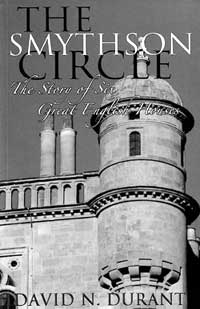Book reviews, Winter 2011
The Smythson Circle; The Story of Six Great English Houses
David N Durant; Peter Owen Publishers, 2011

It is now over 55 years since the publication of Mark Girouard's seminal book Robert Smythson and the Architecture of the Elizabethan Era (1966). Much has been published in the intervening years on different aspects of the most important houses which Girouard identified as being associated with 'the foremost [English] architect of the sixteenth century', Robert Smythson; including Lindsay Boynton's The Hardwick Hall Inventories of 1601 (1971) and Pamela Marshall's Wollaton Hall, An Archaeological Survey (1996) to name but just two. Much has also been published on Elizabethan architecture more generally; from The Making of the English Country House 1540-1640 (1975) by Malcolm Airs to Mark Girouard's recent Elizabethan Architecture (2009). All this new information, from both archaeologists and architectural historians, has been avidly absorbed by David Durant and thoughtfully processed, with a number of his own discoveries and new ideas, to produce an interesting new book which concentrates on the what we know about the way in which these six great houses were actually built, and, as far as possible, who physically built them.
David has concentrated on only six houses, almost all of them in Nottinghamshire and Derbyshire. All these houses are closely linked by a tangled web of disparate associations which have been drawn together in detail in this book. The book explores different themes within the individual chapters which are devoted to separate houses. The disparate nature of their actual methods of building, and the varied sources available for each house, helps to illuminate the different processes of construction employed at this time, from the multi-phase construction of a now ruined house, like Old Hardwick Hall, to the single campaign construction of a surviving house such as Wollaton Hall.
The one thing which enables David to communicate the detail of the construction of these houses is the fact that the building accounts survive, at least in part, for all these houses - a rare survival. This allows him to explore the different methods of organisation used by patrons and architects at this period. For all David's erudition and detailed knowledge, the text is clear and eminently readable. He concentrates his interest on the process of building and most particularly on the part played by the various craftsmen involved.
Charting, where possible, the movements of some craftsmen from one building project to another. Different information survives for each house and David utilises this to discuss different aspects of building and design for different houses, such as the provision of water for the building process at Bolsover Castle and the provision of garderobes and close-stools at Wollaton, allowing the book as a whole to explore many different aspects of why and especially how Elizabethan country houses were built.
My one criticism of the book is its lack of a conclusion. This is in many ways made up for by the lengthy introduction and my personal recommendation would be to re-read the introduction when you come to the end of the book! Unfortunately the illustrations are small, and the photographs are not always of the highest quality.
This reasonably priced paperback will, I am sure, make the ideal Christmas present for anyone interested in Robert Smythson, local country houses or more particularly in the way in which country houses were constructed in the late 16th and early 17th centuries.
Pete Smith